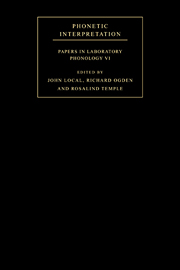Book contents
- Frontmatter
- Contents
- List of contributors
- Acknowledgements
- Introduction
- Part I Phonological representations and the lexicon
- Part II Phonetic interpretation and phrasal structure
- Part III Phonetic interpretation and syllable structure
- 11 On the factorability of phonological units in speech perception
- 12 Articulatory correlates of ambisyllabicity in English glides and liquids
- 13 Extrinsic phonetic interpretation: spectral variation in English liquids
- 14 Temporal constraints and characterising syllable structuring
- 15 Commentary: some thoughts on syllables: an old-fashioned interlude
- Part IV Phonology and natural speech production: tasks, contrasts and explanations
- References
- Index of names
- Index of subjects
14 - Temporal constraints and characterising syllable structuring
Published online by Cambridge University Press: 22 September 2009
- Frontmatter
- Contents
- List of contributors
- Acknowledgements
- Introduction
- Part I Phonological representations and the lexicon
- Part II Phonetic interpretation and phrasal structure
- Part III Phonetic interpretation and syllable structure
- 11 On the factorability of phonological units in speech perception
- 12 Articulatory correlates of ambisyllabicity in English glides and liquids
- 13 Extrinsic phonetic interpretation: spectral variation in English liquids
- 14 Temporal constraints and characterising syllable structuring
- 15 Commentary: some thoughts on syllables: an old-fashioned interlude
- Part IV Phonology and natural speech production: tasks, contrasts and explanations
- References
- Index of names
- Index of subjects
Summary
Introduction: temporal constraint and the syllable
One of the most robust aspects of syntagmatic phonological patterning across languages is a strong tendency for consonants and vowels to collate with one another into structures of the size of a syllable. At the same time, an explicit and simple characterisation of the phonetics of syllables has yet to be found, leading many researchers to the conclusion that no such characterisation will ever be found. Syllabic patterning could be the result of a convergence of several different phonetic factors which each have their roots in different aspects of the speech communication process. In this paper, I will show evidence which indicates that one phonetic aspect of syllabic organisation is a tendency for gestures which inhabit particular locations in a syllable to have particular preferred intergestural timings. The evidence comes from a rate-controlled repetition experiment involving simple coda and onset structures.
The syllable has various uses in linguistic theory, many of which are reviewed in Blevins (1995). First, it acts as a foundational unit in prosodic organisation. Thus, it figures in the construction of prosodic trees and in various operations in prosodic morphology. Also, minimal words often consist of a single syllable in many languages. Second, the syllable often serves as the domain within which segmental cooccurrence restrictions are expressed. A common traditional argument for the syllable is the existence of phonotactic constraints which are easily specified in terms of syllables or syllabic constituents.
Information
- Type
- Chapter
- Information
- Phonetic InterpretationPapers in Laboratory Phonology VI, pp. 253 - 268Publisher: Cambridge University PressPrint publication year: 2004
Accessibility standard: Unknown
Why this information is here
This section outlines the accessibility features of this content - including support for screen readers, full keyboard navigation and high-contrast display options. This may not be relevant for you.Accessibility Information
- 1
- Cited by
